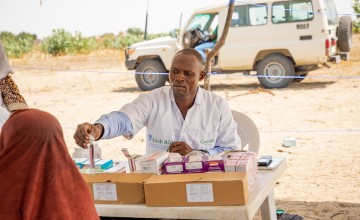
Knowledge Hub
Landlocked and located in central Africa is perhaps one of the lesser-known Sahelian countries: Chad. It is also a country where 5.5 million people - or nearly one in three people - need urgent humanitarian assistance.
An unforgiving climate
With a tropical climate in the south and desert in the north, Chad’s topography varies from broad, arid plains, to vast deserts and mountainous peaks. The weather is predominantly hot and dry and the country suffers from periodic droughts, floods and locust plagues. Chad is particularly impacted by climate change which is exacerbating desertification and may be contributing, in addition to overuse, to altering water levels in Lake Chad: a large, freshwater lake situated at the conjunction of Chad, Cameroon, Nigeria, and Niger.

Since the mid-20th century, temperatures in Chad have been increasing while rainfall is decreasing. Temperature is rising one-and-a-half times faster than the global average [Down to Earth]. Lake Chad, once one of Africa’s largest freshwater bodies and a source of livelihood for about 30 million people, shrunk by 90% between 1960s and the 1990s due to overuse, mismanagement and climate change. About 10.6 million people living in the Lake Chad area are in need of humanitarian assistance [Relief Web].
Ongoing conflict and displacement
This challenging context is exacerbated by the fact that the country has been in civil war or conflict for 35 out of the 57 years since it gained independence from France. After 12 years of conflict in the Lake Chad area, the crisis has no end in sight. In 2020, the number of internally displaced people (IDP) in the area doubled to over 450,000, representing about half of the province's population (there were 169,003 IDPs at the end of 2019). Close to 3 million people have been forced to flee their homes across the Lake Chad Basin and lack adequate living conditions, including shelter, clean water and basic hygiene, and by displacing have lost their sources of income which were mainly farming and fishing.

Moreover, since 2017 Chad has hosted the largest number of refugees in relation to its population density in Africa. Between 3 and 4% of the Chadian population is made up of refugees. In addition to these refugees, Chad also hosts numerous returnees who fled to Sudan (Darfur), the Central African Republic, Cameroon and Nigeria during different periods and are now back in Chad. The areas bordering these countries, already characterised by extreme vulnerability, are all affected by these population movements.
A worsening situation
Most people living in Chad were already contending with high poverty rates, lack of basic services like education and healthcare, and the devastating impact of climate change. But the ever-changing climate and conflict has dramatically worsened the situation, amplifying food and nutritional insecurity in the region. The intense heat and erratic rainfall mean food often doesn’t grow. Conflict has closed borders, which has impacted on beef exports, a major source of income for the country. Work opportunities have dried up because of the ongoing conflict, and the small sums people earn by doing odd jobs are simply not enough. A drop in world oil prices, as well as Covid-19 has also severely affected the fragile economy and the trading of goods, with families being pushed deeper into poverty. Chad was ranked a shocking 187 of 189 countries in the UNDP 2020 Human Development Index. 1.8 million people do not have enough to eat, with children under five most at risk.
What we’re doing to help

We are responding to the humanitarian needs of displaced populations in the Lake Chad area, implementing health and nutrition programmes to deliver life-saving assistance, improving access to clean drinking water and sanitation, and helping people with alternative sources of food and income such as vegetable gardening adapted to local conditions. There are no roads in certain areas of Chad, including Lake Chad – just sand and scrub trees. Our mobile clinics can reach children and families in these remote places. Without them, parents would have to carry their children long distances, sometimes even a day’s walk, to reach a clinic.
Help bring life-saving treatment to children who need it most.
Other ways to help
Donate now
Give a one-off, or a monthly, donation today.
Join an event
From mountain trekking to marathon running, join us for one of our many exciting outdoor events!
Buy a gift
With an extensive range of alternative gifts, we have something to suit everybody.
Leave a gift in your will
Leave the world a better place with a life-changing legacy.
Become a corporate supporter
We partner with a range of organisations that share our passion and the results have been fantastic.
Create your own fundraising event
Raise money for Concern by organising your own charity fundraising event.





